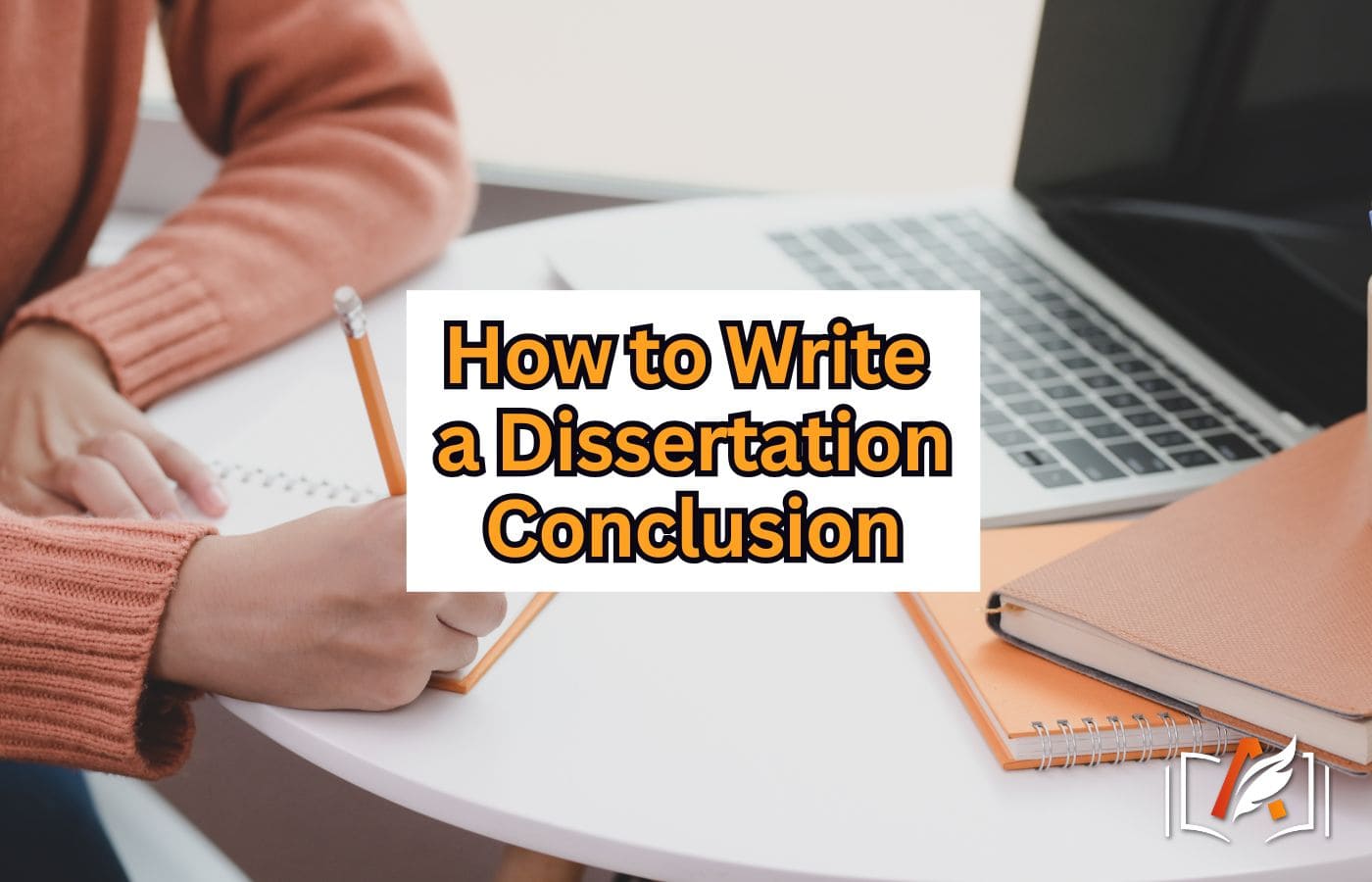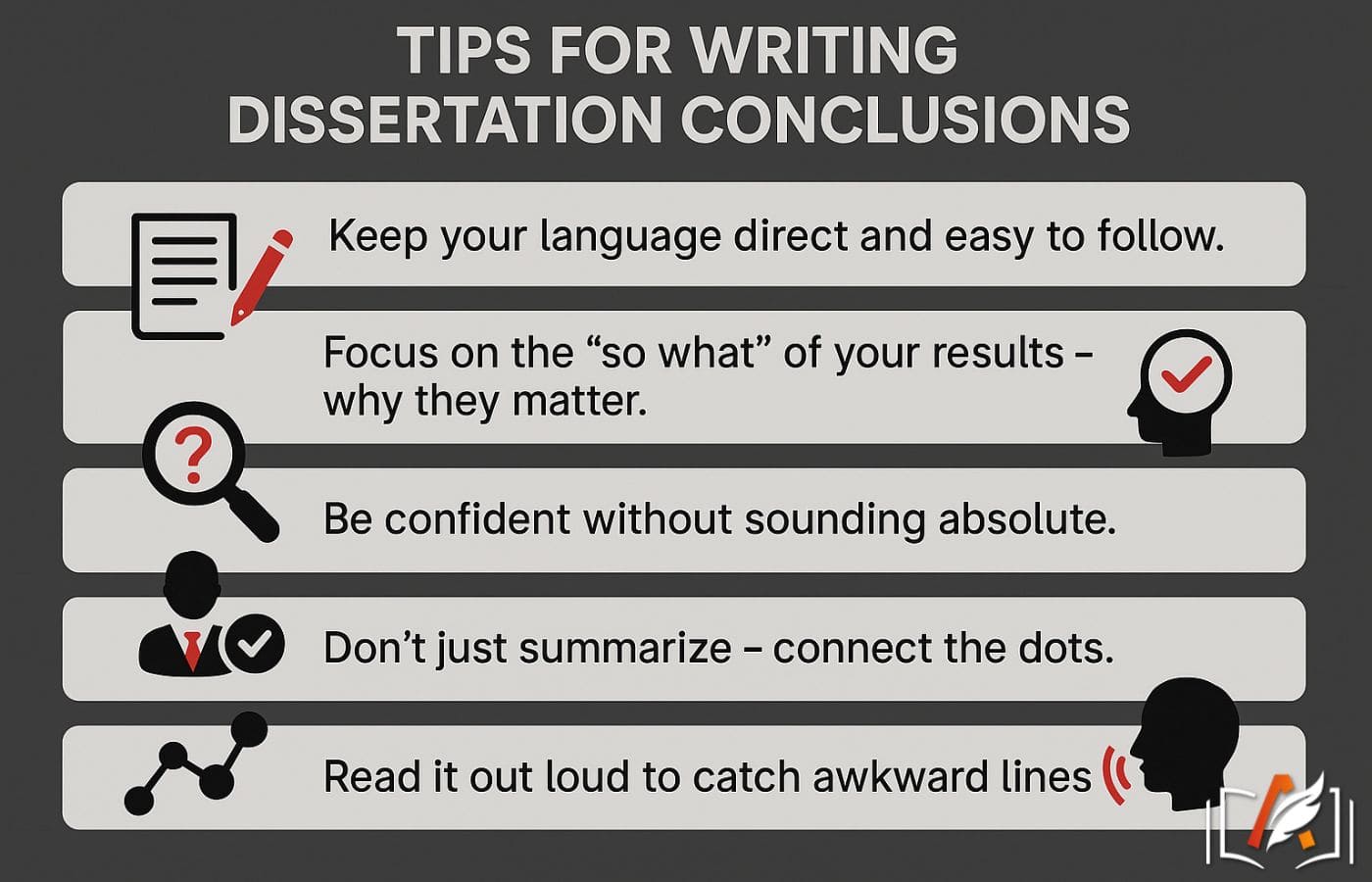 Ruby Butz
Ruby Butz

Finishing your dissertation can feel like relief until you conclude. This final section might seem easy, but it carries weight. So, how to write a good dissertation conclusion? To create an effective ending, we must do more than just summarise.
A reasonable dissertation conclusion briefly restates your research aim, shows how your findings connect to it, and explains why those findings matter. It shouldn’t add new data but give the reader a clear takeaway. We often tell students to think of it as their last word on the topic – the final chance to show what their research contributes. You can tie everything together in just a few focused paragraphs and remind your reader why your work is meaningful.
For more help on how to do this well, read our article on the steps to create a strong dissertation conclusion.
Defining the Dissertation Conclusion
At the end of your dissertation, the conclusion plays a crucial role. This is where everything comes together. You’ve made your case and shared your findings; now it’s time to explain them. A dissertation conclusion isn’t just a summary – it’s a final reflection on the research journey.
This section should answer your primary research question and highlight the key message of your work. Think of it as your final word. It tells readers what to take away from your study and why it matters. A strong ending gives your paper lasting value, especially in academic writing where structure and clarity matter most.
Key Elements to Cover in Your Dissertation Conclusion
Many students ask what to include when drafting this final section. While each project is different, the elements of a good dissertation conclusion often follow a few clear patterns. These help organise the ending in a way that ties everything together smoothly and leaves a strong, professional impression.
- Answer the main research question. Revisit the original goal of your dissertation and give a direct answer.
- Sum up the main findings. Keep it brief – just a few sentences that reflect your strongest points.
- Show the impact of your research. Explain how your findings relate to the broader field or topic.
- Acknowledge limitations. A short, honest note about what your research couldn’t cover adds credibility.
- Offer ideas for future research. Suggest what others might study next based on your work.
Read also: How to Write a Methodology for a Dissertation
What to Leave Out When Ending Your Dissertation
Not everything belongs in the final section. Some students make the mistake of adding too much or straying from the main point, which can weaken the overall message. When you summarise a dissertation, the goal is to wrap up clearly and purposefully, without introducing new ideas or losing focus.
- New data or arguments. It shouldn't appear now if a point didn’t reach the body.
- Detailed results. The conclusion is not the place for charts, figures, or complete analysis.
- Repetition. Avoid repeating complete sentences from earlier chapters. Restate ideas in fresh ways.
- Vague opinions. Keep the tone formal and focused – your claims should be supported, not based on guesswork.
If you’re unsure how to pull it all together, turning to expert help can make a difference. Asking a trusted academic service, State of Writing, to "write my dissertation professionally" ensures your conclusion is clear, polished, and properly aligned with the rest of your work.
A Practical Walkthrough on How to Write a Dissertation Conclusion
The conclusion is the last chance to show what your dissertation means. It’s not just about repeating what’s already been said – it’s about tying everything together. We often remind students that even strong research can lose impact without a clear, well-structured ending. Here’s a simple guide to help you confidently wrap up your work.
Step 1: Begin With a Quick Recap That Sets the Stage
Start with a short paragraph that brings readers back to your research topic. This part should remind them of your primary aim or question without repeating your introduction. It signals that the end is near and helps shift the focus to final thoughts.
Step 2: Highlight the Main Takeaways Without Repeating Chapters
Give a summary of your key results. Don’t list every detail – instead, focus on the points that best answer your original research question. This keeps your conclusion focused and helps the reader remember what mattered most.
Step 3: Explain What Your Study Adds to the Bigger Picture
When writing a dissertation conclusion, clarify how your work fits the subject. Think about how your findings connect to the real world, industry needs, or gaps in previous research. Showing your contribution adds meaning to your results.
Step 4: Be Honest About the Study’s Boundaries
Every project has limits, and that’s okay. Share what you couldn’t explore or where your approach had challenges. Mentioning these points won’t weaken your work – it shows critical thinking and honesty in academic writing.
Step 5: Suggest Where Future Work Could Go
Help other students or researchers by pointing out what needs to be explored. Mention new questions that came up or areas that deserve more attention. This shows that your project opened doors for further discussion.
Step 6: Wrap It All Up With a Clear, Confident Closing
A clear dissertation conclusion structure should end with a paragraph that ties everything together. Revisit your study’s primary purpose and highlight the importance of your findings. Closing with a strong final sentence helps leave a lasting impression on your reader.
Step 7: Take Time to Revisit and Polish Your Work
Once the writing is done, take a step back before reviewing. Minor edits can fix unclear parts, remove repetition, and strengthen your message. Rereading with fresh eyes helps turn a decent conclusion into a strong one.
Read also: Tips on How to Write a Dissertation Introduction
A Sample Conclusion to Show You the Way
Here’s a dissertation conclusion example that shows how to end clearly and effectively:
This study explored the impact of flexible work policies on employee productivity in mid-sized tech firms. The results showed that flexible scheduling and remote options led to measurable gains in output and job satisfaction. While the study was limited by sample size and regional focus, it still provides valuable insight into changing workplace dynamics. These findings could help businesses rethink traditional schedules and develop strategies supporting company goals and employee well-being. Future research might explore industry-specific differences or long-term outcomes of hybrid models.
This sample shows how to conclude the discussion while still adding value. It answers the research question, includes a reflection on limits, and points to what’s next.
Dissertation Conclusion Writing Guidelines You Should Know
Before wrapping up your dissertation, keep these core principles in mind. They’ll help shape a focused, clear, and meaningful conclusion.
- Avoid repeating long parts of earlier chapters.
- Keep the tone professional and balanced.
- Tie every idea back to your primary research question.
- Make sure your answer feels complete and thoughtful.
- Never add new sources or unexplored data.
Struggling to finish your dissertation conclusion with confidence? Professional dissertation services can offer guidance to sharpen your final section. With expert input, your conclusion can reflect your research and wrap up your work with impact.
Tips for Writing Dissertation Conclusions That Strengthen Your Ending
We’ve helped many students improve their final chapters by keeping these small but powerful ideas in mind:

Helpful Formatting and Style Advice
How your conclusion looks can be just as important as what it says. Even strong writing can lose its impact if the formatting is messy.
- Use the same citation style throughout. Stick to the formatting guidelines required by your department, whether it’s APA, MLA, Chicago, or another style. Consistency in headings, in-text citations, and references adds credibility and helps avoid confusion.
- Keep paragraphs short and easy to follow. When writing a conclusion chapter, avoid long blocks of text. Use short, structured paragraphs to keep it clear and easy to read.
- Check margins, spacing, and font size. Review your document’s layout settings to ensure they meet university requirements. This usually means one-inch margins, double-spacing, and a standard font like Times New Roman, size 12.
- Include required headers or titles. If your school asks for labelled sections (e.g., “Conclusion” or “Final Remarks”), make sure they’re correctly placed and styled to match the rest of your paper.
- Proofread carefully before submission. Typos and grammar mistakes can undercut strong arguments. Read your conclusion aloud or have someone else review it to catch errors you might miss after hours of writing.
How to Write a Conclusion for a Dissertation Without Common Mistakes
It’s easy to let small mistakes weaken your final section. After working hard on every chapter, the last thing you want is for the ending to fall short. These are some of the most common missteps we’ve seen and how to avoid them.
- Repeating whole paragraphs or sentences from earlier sections instead of rephrasing key ideas.
- Adding new arguments or examples that should have been introduced earlier.
- Writing too vaguely or avoiding direct answers to the research question.
- Ignoring your study’s limitations can make your conclusion feel incomplete.
- Rushing through the final paragraph instead of giving it weight and clarity.
Expert guidance can make a real difference if you're worried about making these errors. Many students buy impeccable dissertations from experienced authors to ensure their work ends as strongly as it begins.
Easy-to-Use Phrases to Start and Link Your Final Thoughts
It’s common to feel stuck when reaching the final section of your dissertation. These dissertation conclusion writing tips, including helpful sentence starters and transition phrases, can help break through writer’s block and guide your thoughts into a clear, structured finish.
Starters for your first sentence:
- “This research set out to explore…”
- “This study aimed to…”
- “At the core of this project lies…”
Connecting your findings:
- “These results suggest that…”
- “Taken together, the findings indicate…”
- “One key implication of this study is…”
Leading to the end:
- “Looking ahead, future studies might…”
- “Despite certain limitations, this research…”
- “In conclusion, the project has shown…”
How the Conclusion Should Reflect the Introduction
To finalise a dissertation effectively, the conclusion should reflect the same tone and purpose set at the beginning. A strong thesis feels complete when the closing section aligns clearly with the introduction.
Start by returning to your original research aim or question. Rather than copying it, rephrase it and demonstrate how your work answered it. This will remind the reader of your focus without unnecessary repetition.
Keep the tone consistent. If your introduction was formal and direct, maintain that voice through the final paragraph. A shift in tone can disrupt the flow and feel out of place. Also, avoid overpromising. Stick to what your research supports, and let a grounded, well-structured ending leave a lasting impression.
From My Own Experience
When I wrote my dissertation, the conclusion felt more complicated than I expected. I knew what I wanted to say, but I wasn’t sure how to tie everything together without repeating earlier points. The pressure to end strong made it even harder. What helped most was outlining the purpose of each paragraph beforehand – one of the most effective ways to conclude a dissertation with clarity and focus. It gave me a roadmap for building a strong, meaningful final section.
Since then, I’ve advised many students to do the same. Treat the conclusion as more than a summary; it’s your final chance to show why your research matters. A well-structured closing doesn’t just repeat ideas – it connects them, reinforces your argument, and leaves a lasting impression on your reader.
This post explored what makes a dissertation conclusion effective, covering everything from structure and content to tone and formatting. We also highlighted common mistakes, helpful sentence starters, and clear formatting tips to help students learn how to end a dissertation with confidence. Each section offers practical guidance from expert experience to support strong, purposeful writing.
FAQ
Do I need a separate conclusion for every chapter in my dissertation?
While not always required, some chapters, especially findings and discussion, may benefit from brief wrap-ups. Check your school’s guidelines.
What’s the best way to organise my dissertation’s conclusion?
Start by restating your aim, summarising key findings, mentioning limitations, noting contributions, and suggesting areas for future research.
Is there a specific formatting style I should follow for the conclusion section?
Yes, your formatting should match the rest of your dissertation. When writing an impactful dissertation conclusion, follow the required citation style (APA, MLA, Chicago) and stick to layout rules like spacing, font, and margins for a polished, professional finish.
How long should the conclusion of a dissertation be?
A good rule is 5–7% of the total word count. That usually means one to two pages, or roughly 500–1,000 words for most dissertations. Constantly adjust based on your supervisor’s advice.

Meet Ruby Butz, the accomplished author at the StateOfWriting educational blog. With a Master’s in English Literature, notable articles, and extensive teaching experience, she has helped thousands of students develop strong writing skills.
Writers are verified and tested to comply with quality standards.
Work is completed in time and delivered before deadline.
Wide range of subjects and topics of any difficulty covered.
Client id #: 000412
Paper type: Research paperI just wanted to say thank you for the collaboration. You saved me from having to retake modules. The semester is finally coming to an end - just one more month to go, then it’s time to rest. See you next academic year
Client id #: 000411
Paper type: Thesis paperprofessional service on all fronts. my 10-day order was completed in just 6 days, giving me extra time to prepare for submission. very satisfied
Client id #: 000410
Paper type: CourseworkAll was completed just as I wanted. Excellent support - Big thanks to all of you 🙏🤗